Multivariate Statistics, Mineralogy, and Radiological Hazards Assessment Due to the Natural Radioactivity Content in Pyroclastic Products from Mt. Etna, Sicily, Southern Italy
Abstract
:1. Introduction
2. Materials and Methods
2.1. Geological Notes and Sampling
2.2. HPGE Gamma Spectrometry Measurements
2.3. Assessment of Radiological Hazard Effects
2.3.1. Absorbed Gamma Dose Rate
2.3.2. Radium Equivalent Activity
2.3.3. Hazard Indices
2.3.4. The Annual Effective Dose Equivalent Outdoor
2.3.5. Excess Lifetime Cancer Risk
2.4. Statistical Treatments
2.5. XRD Analysis
2.6. MRS Analysis
3. Results and Discussion
3.1. The Activity Concentration of the Radionuclides
3.2. Dose Assessment and Hazard Indices
3.3. Statistical Features
3.4. Mineralogical Composition
4. Conclusions
Author Contributions
Funding
Institutional Review Board Statement
Informed Consent Statement
Data Availability Statement
Conflicts of Interest
References
- United Nations Scientific Committee on the Effects of Atomic Radiation. Sources and Effects of Ionizing Radiation: Report to the General Assembly, with Scientific Annexes; UNSCEAR: New York, NY, USA, 2000; Volume I, ISBN 92-1-142238-8. [Google Scholar]
- Caridi, F.; Acri, G.; Belvedere, A.; Crupi, V.; D’Agostino, M.; Marguccio, S.; Messina, M.; Paladini, G.; Venuti, V.; Majolino, D. Evaluation of the radiological and chemical risk for public health from flour sample investigation. Appl. Sci. 2021, 11, 3646. [Google Scholar] [CrossRef]
- Caridi, F.; Marguccio, S.; Durante, G.; Trozzo, R.; Fullone, F.; Belvedere, A.; D’Agostino, M.; Belmusto, G. Natural radioactivity measurements and dosimetric evaluations in soil samples with a high content of NORM. Eur. Phys. J. Plus 2017, 132, 56. [Google Scholar] [CrossRef]
- Caridi, F.; D’Agostino, M.; Belvedere, A.; Marguccio, S.; Belmusto, G. Radon radioactivity in groundwater from the Calabria region, south of Italy. J. Instrum. 2016, 11, P05012. [Google Scholar] [CrossRef]
- Caridi, F.; D’Agostino, M.; Messina, M.; Marcianò, G.; Grioli, L.; Belvedere, A.; Marguccio, S.; Belmusto, G. Lichens as environmental risk detectors. Eur. Phys. J. Plus 2017, 132, 189. [Google Scholar] [CrossRef]
- Caridi, F.; Messina, M.; D’Agostino, M. An investigation about natural radioactivity, hydrochemistry, and metal pollution in groundwater from Calabrian selected areas, southern Italy. Environ. Earth Sci. 2017, 76, 668. [Google Scholar] [CrossRef]
- Reino, W.; Pucha, G.; Recalde, C.; Tene, T.; Cadena, P. Occurrence of radioactive materials in pyroclastic flows of Tungurahua volcano using gamma spectrometry. In AIP Conference Proceedings; AIP Publishing LLC: Melville, NY, USA, 2018; Volume 2003, p. 020014. [Google Scholar] [CrossRef]
- Raja, S.L.; Marpaung, H.; Simanjuntak, S.; Simanjuntak, C.; Pudjadi, E. Distribution and risk assessment of natural radioactive elements in volcanic ashes, cold lava, river waters due to volcanic eruption of Mount Sinabung. In AIP Conference Proceedings; AIP Publishing LLC: Melville, NY, USA, 2021; Volume 2342, p. 020008. [Google Scholar] [CrossRef]
- Zagorodnyuk, L.H.; Mestnikov, A.E.; Makhortov, D.S.; Akhmed, A.A.A. Mixed binders with the use of volcanic ash. Lect. Notes Civ. Eng. 2021, 95, 9–15. [Google Scholar] [CrossRef]
- Ahmedai, M.A.; Ahmed, S.A.M.; Ahmed, Y.H.; Ibrahiem, E.-S.M. Tagabo Volcanic Ash as Cement Replacing Materials. FES J. Eng. Sci. 2021, 9, 35–39. [Google Scholar] [CrossRef]
- Ranatunga, T.D.; Taylor, R.W.; Bhat, K.N.; Reddy, S.S.; Senwo, Z.N.; Jackson, B. Inorganic phosphorus forms in soufrière hills volcanic ash and volcanic ash-derived soil. Soil Sci. 2009, 174, 430–438. [Google Scholar] [CrossRef]
- Chester, D.K.; Duncan, A.M.; Guest, J.E.; Kilburn, C.R.J. Mount Etna. The Anatomy of a Volcano. Geol. Mag. 1986, 123, 463–464. [Google Scholar] [CrossRef]
- Tanguy, J.-C.; Condomines, M.; Kieffer, G. Evolution of the Mount Etna magma: Constraints on the present feeding system and eruptive mechanism. J. Volcanol. Geotherm. Res. 1997, 75, 221–250. [Google Scholar] [CrossRef]
- Gvirtzman, Z.; Nur, A. The formation of Mount Etna as the consequence of slab rollback. Nature 1999, 401, 782–785. [Google Scholar] [CrossRef]
- Condomines, M.; Tanguy, J.-C.; Michaud, V. Magma dynamics at Mt Etna: Constraints from U-Th-Ra-Pb radioactive disequilibria and Sr isotopes in historical lavas. Earth Planet. Sci. Lett. 1995, 132, 25–41. [Google Scholar] [CrossRef]
- Kozłowska, B.; Walencik-łata, A.; Giammanco, S.; Immè, G.; Catalano, R.; Mangano, G. Radioactivity of mt. Etna volcano and radionuclides transfer to groundwater. Ann. Geophys. 2019, 62, VO565. [Google Scholar] [CrossRef]
- Caridi, F.; D’Agostino, M.; Belvedere, A.; Marguccio, S.; Belmusto, G.; Gatto, M.F. Diagnostics techniques and dosimetric evaluations for environmental radioactivity investigations. J. Instrum. 2016, 11, C10012. [Google Scholar] [CrossRef]
- Omar-Nazir, L.; Shi, X.; Moller, A.; Mousseau, T.; Byun, S.; Hancock, S.; Seymour, C.; Mothersill, C. Long-term effects of ionizing radiation after the Chernobyl accident: Possible contribution of historic dose. Environ. Res. 2018, 165, 55–62. [Google Scholar] [CrossRef]
- Giorgia Potortì, A.; Francesco Mottese, A.; Rita Fede, M.; Sabatino, G.; Dugo, G.; Lo Turco, V.; Costa, R.; Caridi, F.; Di Bella, M.; Di Bella, G. Multielement and chemometric analysis for the traceability of the Pachino Protected Geographical Indication (PGI) cherry tomatoes. Food Chem. 2022, 386, 132746. [Google Scholar] [CrossRef] [PubMed]
- Mottese, A.F.; Sabatino, G.; Di Bella, M.; Fede, M.R.; Parisi, F.; Marcianò, G.; Tripodo, A.; Italiano, F.; Dugo, G.; Caridi, F. Contribution of soil compositions, harvested times and varieties on chemical fingerprint of Italian and Turkish citrus cultivars. Int. J. Food Sci. Technol. 2021, 56, 2628–2639. [Google Scholar] [CrossRef]
- Andronico, D.; Corsaro, R. Lava fountains during the episodic eruption of South-East Crater (Mt. Etna), 2000: Insights into magma-gas dynamics within the shallow volcano plumbing system. Bull. Volcanol. 2011, 73, 1165–1178. [Google Scholar] [CrossRef]
- Hirn, A.; Nicolich, R.; Gallart, J.; Laigle, M.; Cernobori, L. ETNASEIS Scientific Group Roots of Etna volcano in faults of great earthquakes. Earth Planet. Sci. Lett. 1997, 148, 171–191. [Google Scholar] [CrossRef]
- Giammanco, S.; Valenza, M.; Pignato, S.; Giammanco, G. Mg, Mn, Fe, and V concentrations in the ground waters of Mount Etna (Sicily). Water Res. 1996, 30, 378–386. [Google Scholar] [CrossRef]
- Fano, V.; Cernigliaro, A.; Scondotto, S.; Perucci, C.A.; Forastiere, F. The fear of volcano: Short-term health effects after Mount Etna’s eruption in 2002. Eur. Respir. J. 2010, 36, 1216–1218. [Google Scholar] [CrossRef] [PubMed]
- Cultrone, G. The use of Mount Etna volcanic ash in the production of bricks with good physical-mechanical performance: Converting a problematic waste product into a resource for the construction industry. Ceram. Int. 2022, 48, 5724–5736. [Google Scholar] [CrossRef]
- Spoto, S.E.; Boncaldo, A.; Capodivento, A.; Di Agosto, M.; Maccarrone, D.; Scibilia, D. Aviation and volcanic ash hazards: A flipped classroom approach to study complex systems. AAPP Atti Della Accad. Peloritana Pericolanti-Cl. Sci. Fis. Mat. Nat. 2021, 99, 36. [Google Scholar] [CrossRef]
- Rizza, U.; Brega, E.; Caccamo, M.T.; Castorina, G.; Morichetti, M.; Munaò, G.; Passerini, G.; Magazù, S. Analysis of the ETNA 2015 Eruption Using WRF–Chem Model and Satellite Observations. Atmosphere 2020, 11, 1168. [Google Scholar] [CrossRef]
- Stewart, C.; Horwell, C.; Plumlee, G.; Cronin, S.; Delmelle, P.; Baxter, P.; Calkins, J.; Damby, D.; Morman, S.; Oppenheimer, C. Protocol for analysis of volcanic ash samples for assessment of hazards from leachable elements. IAVCEI Comm. Jt. Rep. Int. Volcan. Health Hazard Netw. Cities Volcanoes 2013, 1, 1–22. [Google Scholar]
- Caridi, F.; Messina, M.; Belvedere, A.; D’Agostino, M.; Marguccio, S.; Settineri, L.; Belmusto, G. Food salt characterization in terms of radioactivity and metals contamination. Appl. Sci. 2019, 9, 2882. [Google Scholar] [CrossRef]
- Ortec Gamma Vision Software User Manual. Available online: https://www.ortec-online.com/products/application-software/gammavision (accessed on 18 July 2022).
- Caridi, F.; D’Agostino, M.; Belvedere, A. Radioactivity in calabrian (Southern Italy) wild boar meat. Appl. Sci. 2020, 10, 3580. [Google Scholar] [CrossRef]
- Caridi, F.; Belvedere, A.; Agostino, M.D.; Marguccio, S.; Marino, G.; Messina, M.; Belmusto, G. An investigation on airborne particulate radioactivity, heavy metals and polycyclic aromatic hydrocarbons composition in Calabrian selected sites, Southern Italy. Indian J. Environ. Prot. 2019, 39, 321–326. [Google Scholar]
- ACCREDIA. Available online: https://www.accredia.it (accessed on 18 July 2022).
- Picciotto, A.; Krása, J.; Láska, L.; Rohlena, K.; Torrisi, L.; Gammino, S.; Mezzasalma, A.M.; Caridi, F. Plasma temperature and ion current analysis of gold ablation at different laser power rates. Nucl. Instr. and Meth. in Phys. Res. Sect. B 2006, 247, 261–267. [Google Scholar] [CrossRef]
- Caridi, F.; Testagrossa, B.; Acri, G. Elemental composition and natural radioactivity of refractory materials. Environ. Earth Sci. 2021, 80, 170. [Google Scholar] [CrossRef]
- Ravisankar, R.; Vanasundari, K.; Chandrasekaran, A.; Rajalakshmi, A.; Suganya, M.; Vijayagopal, P.; Meenakshisundaram, V. Measurement of natural radioactivity in building materials of Namakkal, Tamil Nadu, India using gamma-ray spectrometry. Appl. Radiat. Isot. 2012, 70, 699–704. [Google Scholar] [CrossRef] [PubMed]
- Beretka, J.; Matthew, P.J. Natural radioactivity of Australian building materials, industrial wastes and by-products. Health Phys. 1985, 48, 87–95. [Google Scholar] [CrossRef]
- Sabatino, G.; Di Bella, M.; Caridi, F.; Italiano, F.; Romano, D.; Magazù, S.; Gnisci, A.; Faggio, G.; Messina, G.; Santangelo, S.; et al. Radiological assessment, mineralogy and geochemistry of the heavy-mineral placers from the Calabrian coast (South Italy). J. Instrum. 2019, 14, P05015. [Google Scholar] [CrossRef]
- Ramasamy, V.; Suresh, G.; Meenakshisundaram, V.; Ponnusamy, V. Horizontal and vertical characterization of radionuclides and minerals in river sediments. Appl. Radiat. Isot. 2011, 69, 184–195. [Google Scholar] [CrossRef] [PubMed]
- Avwiri, G.O.; Egieya, J.M. Radiometric assay of hazard indices and excess lifetime cancer risk due to natural radioactivity in soil profile in Ogba/Egbema/Ndoni local government area of Rivers state, Nigeria. Acad. Res. Int. 2013, 4, 54–65. [Google Scholar]
- Taskin, H.; Karavus, M.; Ay, P.; Topuzoglu, A.; Hidiroglu, S.; Karahan, G. Radionuclide concentrations in soil and lifetime cancer risk due to gamma radioactivity in Kirklareli, Turkey. J. Environ. Radioact. 2009, 100, 49–53. [Google Scholar] [CrossRef]
- Caridi, F.; D’Agostino, M.; Belvedere, A.; Mottese, A.F. Multi-element Analysis and Geographical Origin Classification of Italian (Calabrian) Wines. Curr. Nutr. Food Sci. 2020, 16, 1259–1264. [Google Scholar] [CrossRef]
- Mottese, A.F.; Fede, M.R.; Caridi, F.; Sabatino, G.; Marcianò, G.; Ravenda, P.; Gaetano, A.D.; Dugo, G. Fingerprint of PGI Mantova Cucumis melo by ICP-MS and Chemometric Analysis. Curr. Nutr. Food Sci. 2021, 17, 94–104. [Google Scholar] [CrossRef]
- Albergamo, A.; Mottese, A.F.; Bua, G.; Caridi, F.; Sabatino, G.; Barrega, L.; Costa, R.; Dugo, G. Discrimination of the Sicilian Prickly Pear (Opuntia Ficus-Indica L., CV. Muscaredda) According to the Provenance by Testing Unsupervised and Supervised Chemometrics. J. Food Sci. 2018, 83, 2933–2942. [Google Scholar] [CrossRef]
- Mottese, A.F.; Sabatino, G.; Di Bella, M.; Fede, M.R.; Caridi, F.; Parisi, F.; Marcianò, G.; Caccamo, M.T.; Italiano, F.; Yuce, G.; et al. Environmental screening for the assessment of potentially toxic elements content in PGI soils from the Mediterranean region (Italy and Turkey). Environ. Earth Sci. 2020, 79, 499. [Google Scholar] [CrossRef]
- Malvern Panalytical. Empyrean Diffractometer User Manual; Malvern Panalytical Ltd.: Malvern, UK, 2013. [Google Scholar]
- Available online: https://www.icdd.com (accessed on 18 July 2022).
- BW TEK BTR 111 Mini-RamTM Datasheet. 2019. Available online: https://bwtek.com/products/i-raman-plus/ (accessed on 18 July 2022).
- Crupi, V.; D’Amico, S.; Denaro, L.; Donato, P.; Majolino, D.; Paladini, G.; Persico, R.; Saccone, M.; Sansotta, C.; Spagnolo, G.V.; et al. Mobile Spectroscopy in Archaeometry: Some Case Study. J. Spectrosc. 2018, 2018, 8295291. [Google Scholar] [CrossRef]
- Caridi, F.; Santangelo, S.; Faggio, G.; Gnisci, A.; Messina, G.; Belmusto, G. Compositional and Mineralogical Analysis of Marine Sediments from Calabrian Selected Areas, Southern Italy. Int. J. Environ. Res. 2019, 13, 571–580. [Google Scholar] [CrossRef]
- Warr, L.N. IMA–CNMNC approved mineral symbols. Mineral. Mag. 2021, 85, 291–320. [Google Scholar] [CrossRef]
- Morelli, D.; Immé, G.; Cammisa, S.; Catalano, R.; Mangano, G.; La Delfa, S.; Patanè, G. Radioactivity measurements in volcano-tectonic area for geodynamic process study. Eur. Phys. J. Web Conf. 2012, 24, 05009. [Google Scholar] [CrossRef]
- Ramasamy, V.; Meenakshisundaram, V.; Venkatachalapathy, R.; Ponnusamy, V. Influence of mineralogical and heavy metal composition on natural radionuclide concentrations in the river sediments. Appl. Radiat. Isot. 2011, 69, 1466–1474. [Google Scholar] [CrossRef]
- Italian Legislation D.Lgs. 101/20. Available online: https://www.gazzettaufficiale.it/eli/gu/2020/08/12/201/so/29/sg/pdf (accessed on 18 July 2022).
- Qureshi, A.A.; Tariq, S.; Din, K.U.; Manzoor, S.; Calligaris, C.; Waheed, A. Evaluation of excessive lifetime cancer risk due to natural radioactivity in the rivers sediments of Northern Pakistan. J. Radiat. Res. Appl. Sci. 2014, 7, 438–447. [Google Scholar] [CrossRef]
- Mohd Razali, N.; Yap, B. Power Comparisons of Shapiro-Wilk, Kolmogorov-Smirnov, Lilliefors and Anderson-Darling Tests. J. Stat. Model. Anal. 2011, 2, 21–33. [Google Scholar]
- Seier, E. Normality Tests: Power Comparison BT-International Encyclopedia of Statistical Science; Lovric, M., Ed.; Springer: Berlin/Heidelberg, Germany, 2011; pp. 1000–1003. ISBN 978-3-642-04898-2. [Google Scholar]
- Weide, A.C.; Beauducel, A. Varimax Rotation Based on Gradient Projection Is a Feasible Alternative to SPSS. Front. Psychol. 2019, 10, 645. [Google Scholar] [CrossRef]
- Freeman, J.J.; Wang, A.; Kuebler, K.E.; Jolliff, B.L.; Haskin, L.A. Characterization of natural feldspars by raman spectroscopy for future planetary exploration. Can. Mineral. 2008, 46, 1477–1500. [Google Scholar] [CrossRef]
- Mckeown, D.A. Raman spectroscopy and vibrational analyses of albite: From 25 °C through the melting temperature. Am. Mineral. 2005, 90, 1506–1517. [Google Scholar] [CrossRef]
- Buzatu, A.; Buzgar, N. The Raman study of single-chain silicates. An. Stiintifice De Univ. AI Cuza Din Iasi. Sect. 2 Geol. 2010, 56, 107–125. [Google Scholar]
- Kolesov, B.; Geiger, C. A Raman spectroscopic study of Fe–Mg olivines. Phys. Chem. Miner. 2004, 31, 142–154. [Google Scholar] [CrossRef]
- Zinin, P.; Tatsumi-Petrochilos, L.; Bonal, L.; Acosta, T.; Hammer, J.; Gilder, S.; Fuller, M. Raman spectroscopy of titanomagnetites: Calibration of the intensity of Raman peaks as a sensitive indicator for their Ti content. Am. Mineral. 2011, 96, 1537–1546. [Google Scholar] [CrossRef]
- Corsaro, R.; Miraglia, L.; Pompilio, M. Petrologic evidence of a complex plumbing system feeding the July–August 2001 eruption of Mt. Etna, Sicily, Italy. Bull. Volcanol. 2007, 69, 401–421. [Google Scholar] [CrossRef]
- Corsaro, R.; Miraglia, L. Dynamics of 2004-2005 Mt. Etna effusive eruption as inferred from petrologic monitoring. Geophys. Res. Lett. 2005, 32, 13302. [Google Scholar] [CrossRef]
- Sigurdsson, H. Part I Origin and Transport of Magma. In The Encyclopedia of Volcanoes, 2nd ed.; Sigurdsson, H.B.T.-T.E. of V.; Academic Press: Amsterdam, The Netherlands, 2015; pp. 33–34. ISBN 978-0-12-385938-9. [Google Scholar]
- Di Genova, D.; Brooker, R.A.; Mader, H.M.; Drewitt, J.W.E.; Longo, A.; Deubener, J.; Neuville, D.R.; Fanara, S.; Shebanova, O.; Anzellini, S.; et al. In situ observation of nanolite growth in volcanic melt: A driving force for explosive eruptions. Sci. Adv. 2020, 6, eabb0413. [Google Scholar] [CrossRef]
- Witham, C.S.; Oppenheimer, C.; Horwell, C.J. Volcanic ash-leachates: A review and recommendations for sampling methods. J. Volcanol. Geotherm. Res. 2005, 141, 299–326. [Google Scholar] [CrossRef]
- Cangemi, M.; Speziale, S.; Madonia, P.; D’Alessandro, W.; Andronico, D.; Bellomo, S.; Brusca, L.; Kyriakopoulos, K. Potentially harmful elements released by volcanic ashes: Examples from the Mediterranean area. J. Volcanol. Geotherm. Res. 2017, 337, 16–28. [Google Scholar] [CrossRef]
- Smith, D.B.; Zielinski, R.A.; Rose, W.I. Leachability of uranium and other elements from freshly erupted volcanic ash. J. Volcanol. Geotherm. Res. 1982, 13, 1–30. [Google Scholar] [CrossRef]
- Aiuppa, A.; Allard, P.; D’Alessandro, W.; Agnès, M.; Parello, F.; Treuil, M.; Valenza, M. Mobility and fluxes of major, minor and trace metals during basalt weathering and groundwater transport at Mt. Etna volcano (Sicily). Geochim. Cosmochim. Acta 2000, 64, 1827–1841. [Google Scholar] [CrossRef]
- Gislason, S.R.; Oelkers, E.H. Mechanism, rates, and consequences of basaltic glass dissolution: II. An experimental study of the dissolution rates of basaltic glass as a function of pH and temperature. Geochim. Cosmochim. Acta 2003, 67, 3817–3832. [Google Scholar] [CrossRef]
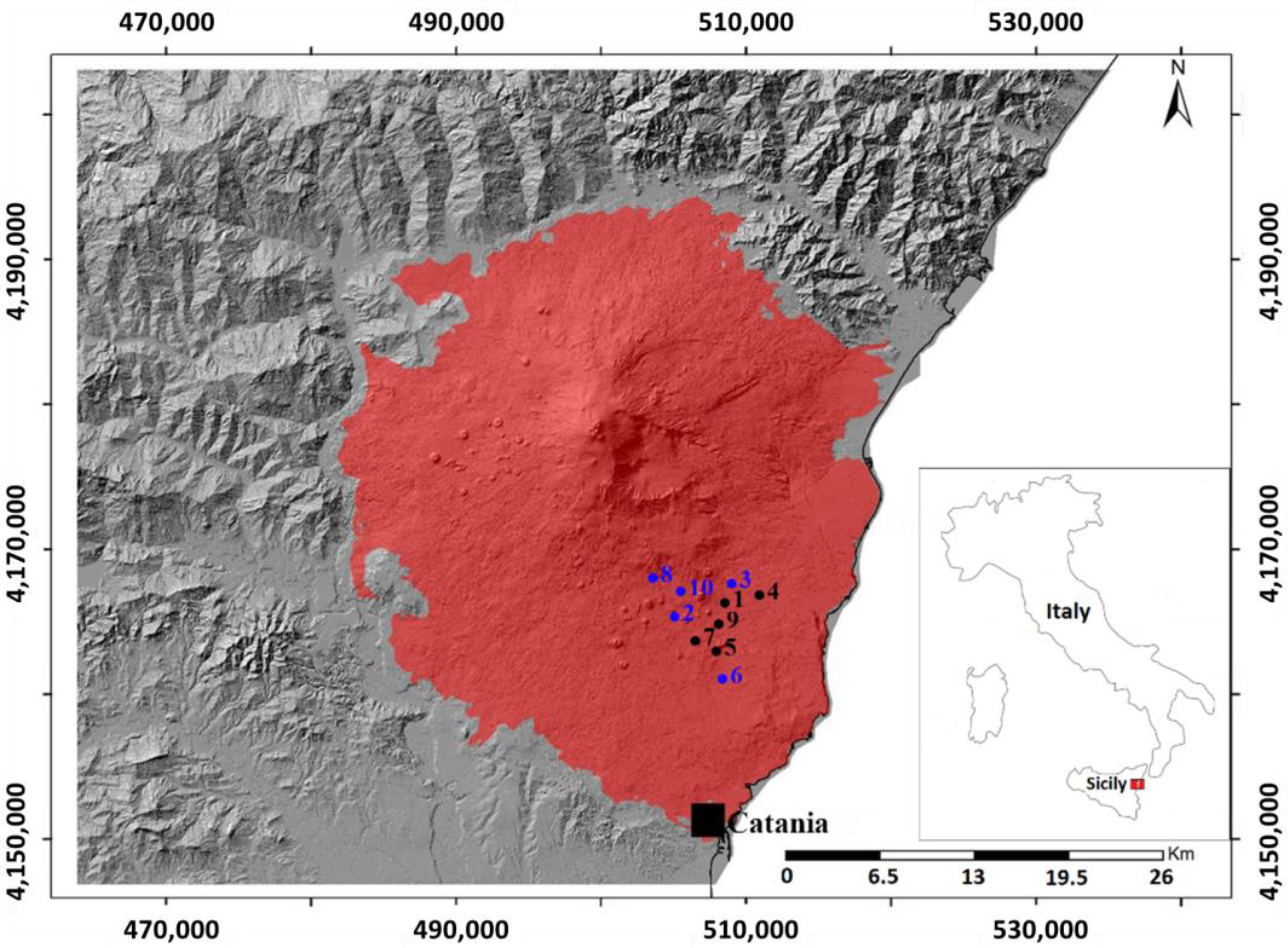
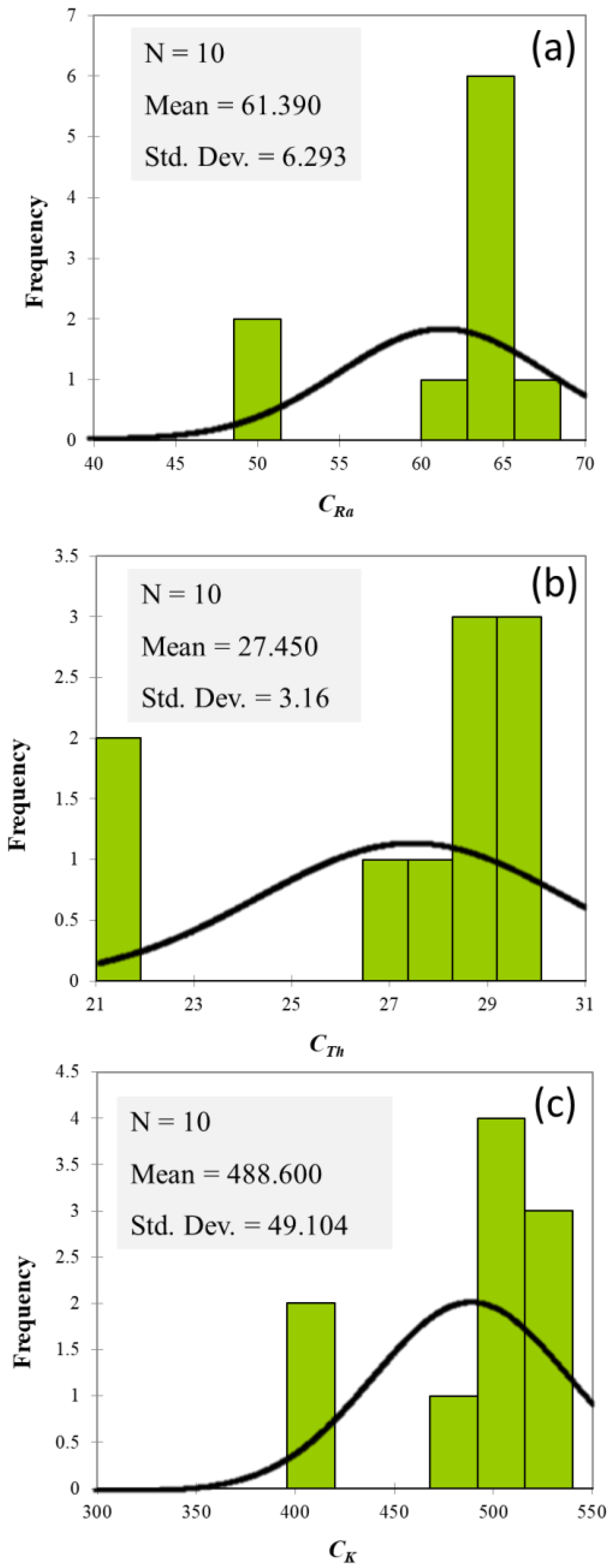
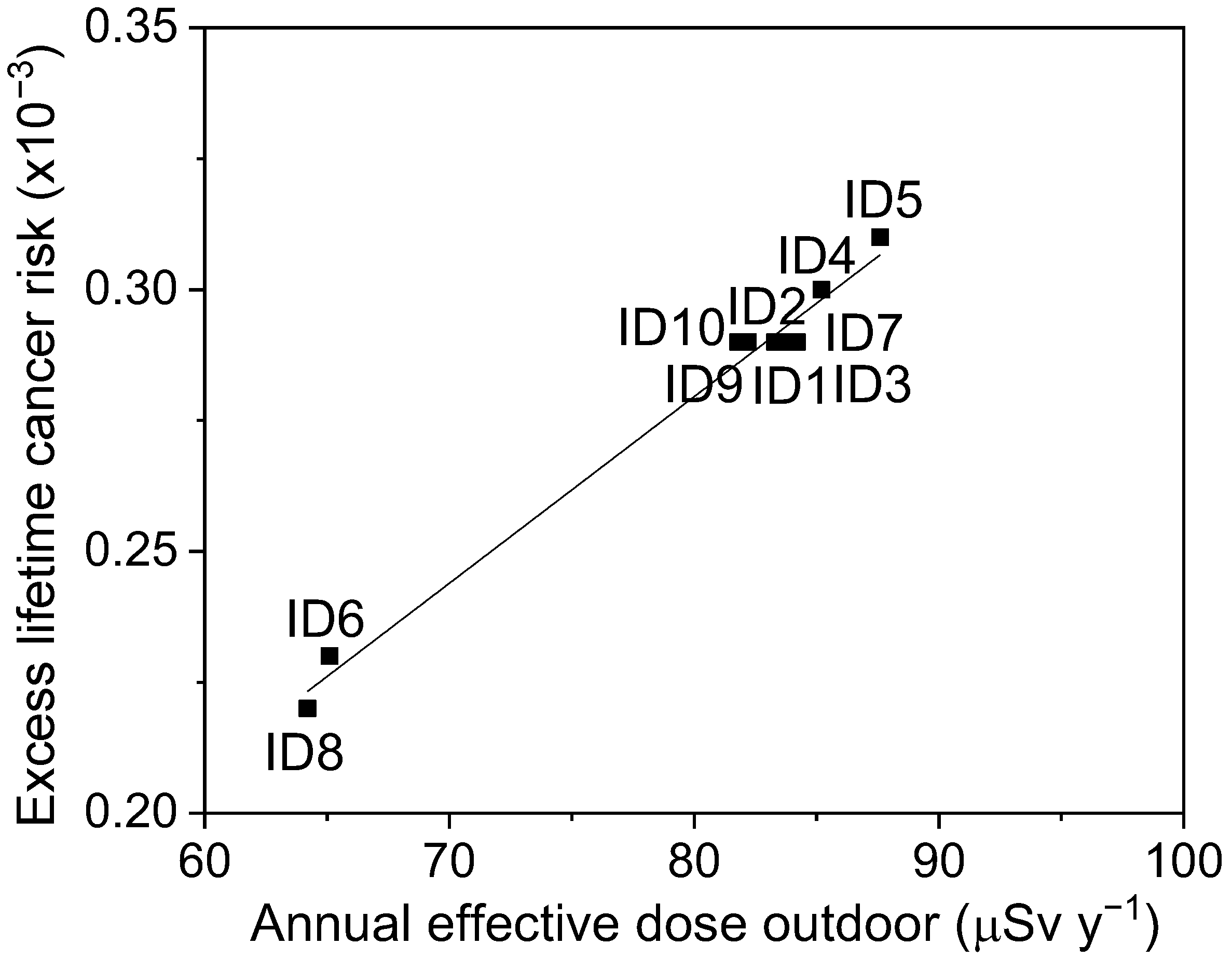
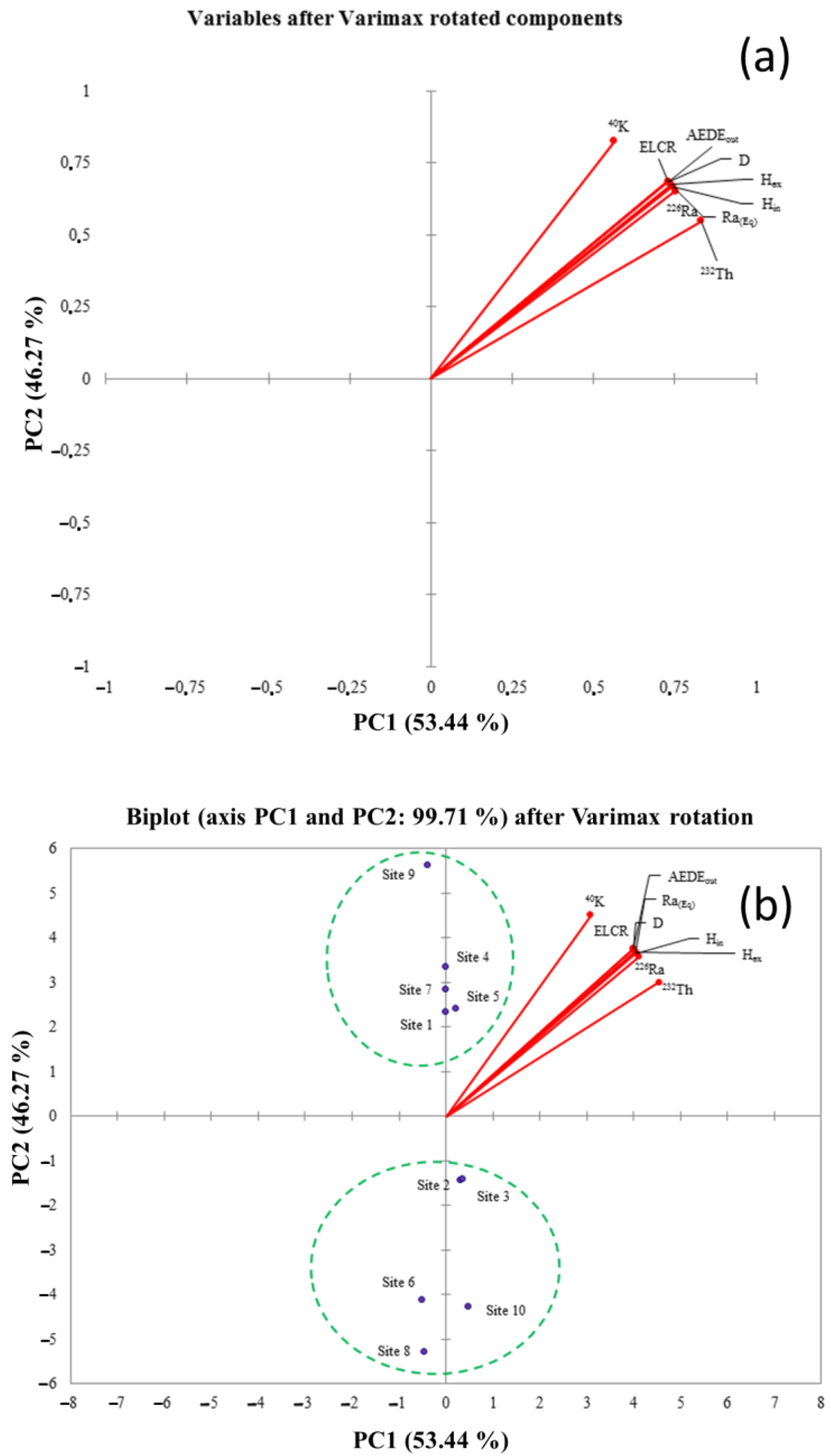
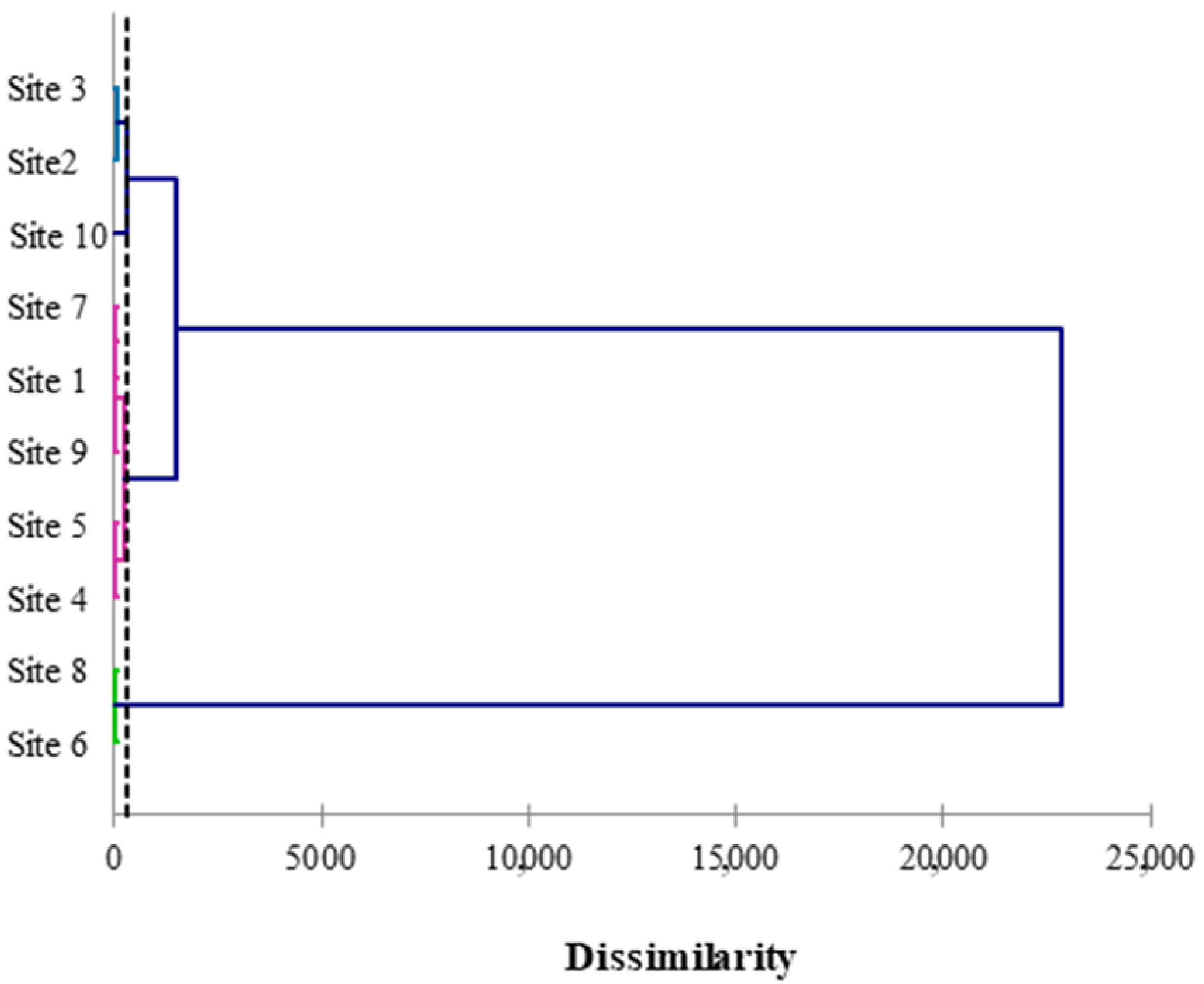
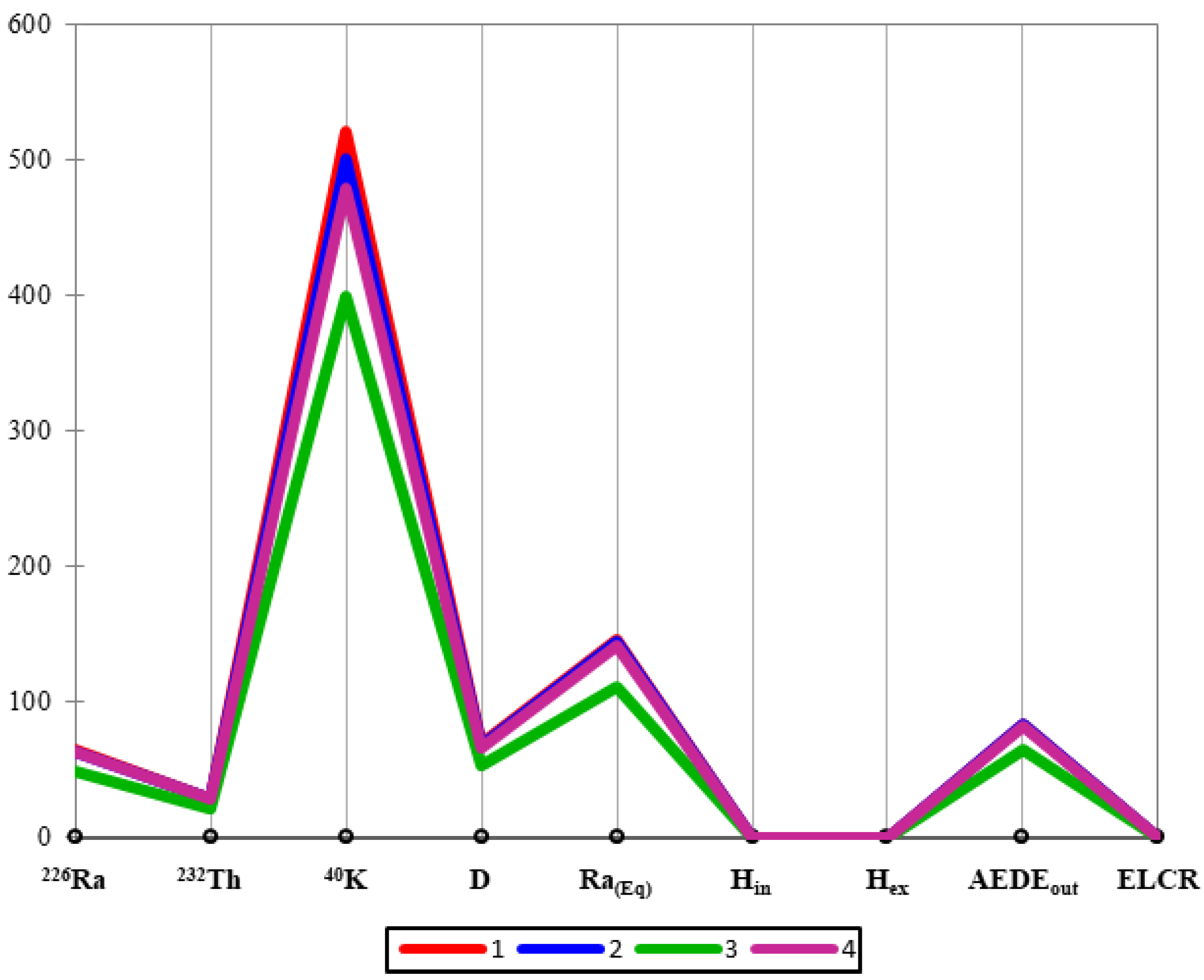
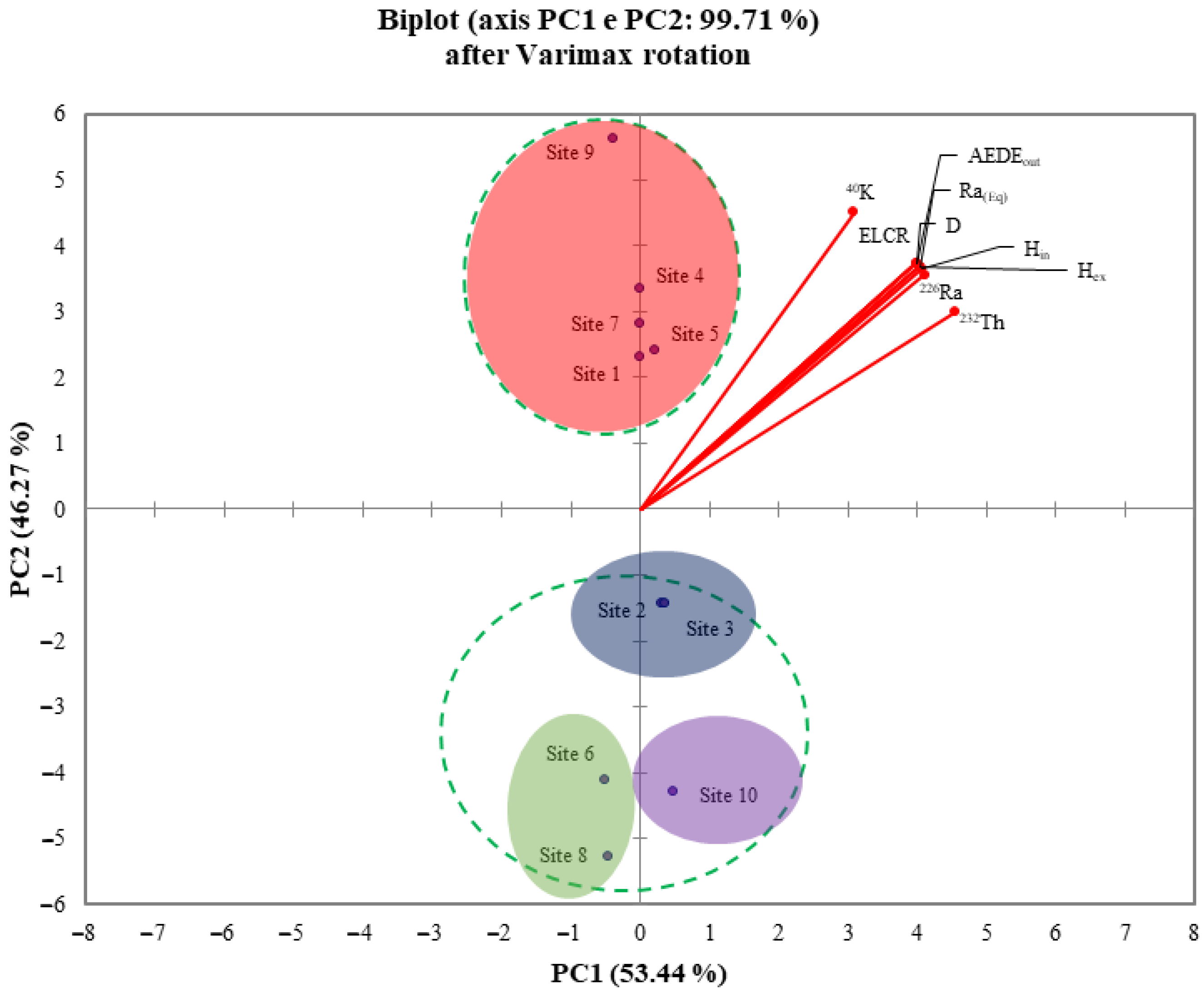

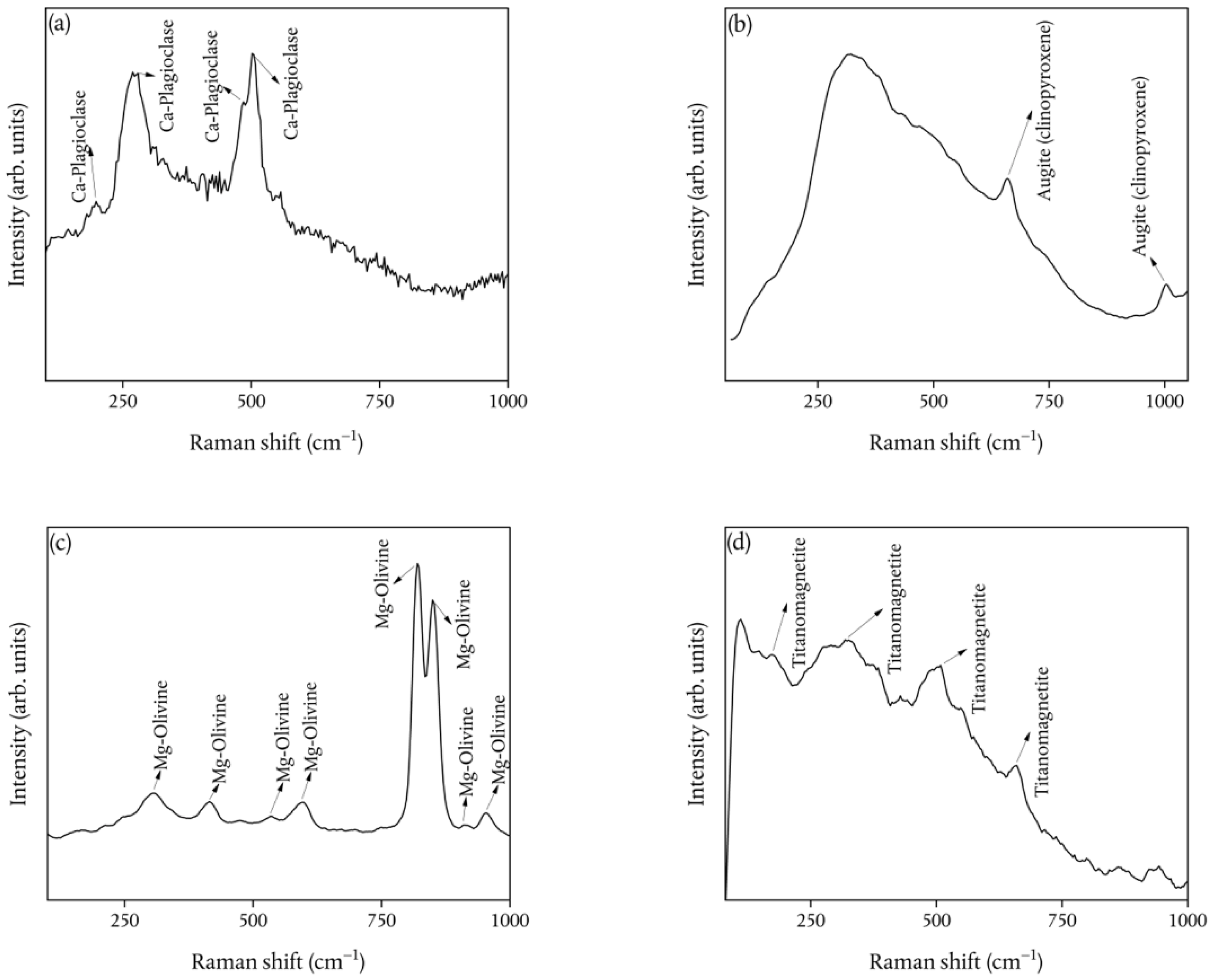
| Site ID | Sampling Site | GPS Position | |
|---|---|---|---|
| Latitude | Longitude | ||
| 1 | Zafferana Etnea | 37.688641 | 15.094988 |
| 2 | Tarderia | 37.649748 | 15.056632 |
| 3 | Milo | 37.71456 | 15.116151 |
| 4 | Santa Venerina | 37.688089 | 15.131235 |
| 5 | Viagrande | 37.615743 | 15.098462 |
| 6 | S. Giovanni La Punta | 37.57984 | 15.093265 |
| 7 | Pedara | 37.618727 | 15.056004 |
| 8 | Rifugio Sapienza | 37.698988 | 15.001205 |
| 9 | Fleri | 37.652492 | 15.095406 |
| 10 | Piano del Vescovo | 37.699004 | 15.053896 |
| GMX Detector | |
|---|---|
| Parameter | Value |
| FWHM | 1.94 keV |
| Peak/Compton | 65:1 |
| εr | 37.5% (at the 1.33 MeV 60Co γ-line) |
| ΔV | −4800 V |
| ΔεE | 5 keV–2 MeV |
| Site ID | CRa (Bq kg−1 d.w.) | CTh (Bq kg−1 d.w.) | CK (Bq kg−1 d.w.) |
|---|---|---|---|
| 1 | 63.5 ± 7.2 | 28.7 ± 3.9 | 515 ± 60 |
| 2 | 64.6 ± 7.3 | 28.8 ± 3.9 | 495 ± 56 |
| 3 | 63.4 ± 7.1 | 29.9 ± 4.3 | 506 ± 58 |
| 4 | 64.2 ± 7.1 | 29.4 ± 4.2 | 528 ± 62 |
| 5 | 67.5 ± 7.5 | 30.0 ± 4.3 | 530 ± 61 |
| 6 | 50.1 ± 5.7 | 21.7 ± 3.0 | 404 ± 47 |
| 7 | 65.4 ± 7.3 | 28.2 ± 3.8 | 514 ± 58 |
| 8 | 49.4 ± 5.6 | 21.6 ± 3.1 | 396 ± 46 |
| 9 | 62.4 ± 7.1 | 27.2 ± 3.9 | 519 ± 61 |
| 10 | 63.4 ± 7.1 | 28.9 ± 4.0 | 479 ± 55 |
| Statistically Function | CRa | CTh | CK |
|---|---|---|---|
| Min | 49.4 | 21.6 | 396 |
| Max | 67.5 | 30.0 | 530 |
| Mean | 61.39 | 27.45 | 488.6 |
| Geometric mean | 61.07 | 27.26 | 486.18 |
| Median | 63.45 | 28.75 | 510.00 |
| Standard deviation | 5.97 | 3.00 | 46.58 |
| Skewness | −1.31 | −1.26 | −1.19 |
| Kurtosis | 0.05 | −0.08 | −0.20 |
| Site ID | D (nGy h−1) | Raeq (Bq kg−1) | Hin | Hex | AEDEout (µSv y−1) | ELCR (×10−3) |
|---|---|---|---|---|---|---|
| 1 | 68.1 | 144 | 0.56 | 0.39 | 83.6 | 0.29 |
| 2 | 67.9 | 144 | 0.56 | 0.39 | 83.3 | 0.29 |
| 3 | 68.5 | 145 | 0.56 | 0.39 | 84.0 | 0.29 |
| 4 | 69.4 | 147 | 0.57 | 0.40 | 85.2 | 0.30 |
| 5 | 71.4 | 151 | 0.59 | 0.41 | 87.6 | 0.31 |
| 6 | 53.1 | 112 | 0.44 | 0.30 | 65.1 | 0.23 |
| 7 | 68.7 | 145 | 0.57 | 0.39 | 84.2 | 0.29 |
| 8 | 52.4 | 111 | 0.43 | 0.30 | 64.2 | 0.22 |
| 9 | 66.9 | 141 | 0.55 | 0.38 | 82.2 | 0.29 |
| 10 | 66.7 | 142 | 0.55 | 0.38 | 81.8 | 0.29 |
| Average | 65.3 | 138 | 0.54 | 0.37 | 80.2 | 0.28 |
| Variables | p-Value | ||
|---|---|---|---|
| Shapiro–Wilk | Anderson-Darling | Lilliefors | |
| CRa | 0.001 | 0.001 | 0.000 |
| CTh | 0.002 | 0.002 | 0.015 |
| CK | 0.006 | 0.006 | 0.007 |
| Variables | CRa | CTh | CK | D | Raeq | Hin | Hex | AEDEout | ELCR |
|---|---|---|---|---|---|---|---|---|---|
| CRa | 1 | ||||||||
| CTh | 0.970 | 1 | |||||||
| CK | 0.954 | 0.925 | 1 | ||||||
| D | 0.994 | 0.980 | 0.975 | 1 | |||||
| Raeq | 0.994 | 0.983 | 0.972 | 1.000 | 1 | ||||
| Hin | 0.997 | 0.980 | 0.968 | 0.999 | 0.999 | 1 | |||
| Hex | 0.994 | 0.983 | 0.972 | 1.000 | 1.000 | 0.999 | 1 | ||
| AEDEout | 0.994 | 0.980 | 0.975 | 1.000 | 1.000 | 0.999 | 1.000 | 1 | |
| ELCR | 0.994 | 0.980 | 0.975 | 1.000 | 1.000 | 0.999 | 1.000 | 1.000 | 1 |
| PC1 | PC2 | PC3 | |
|---|---|---|---|
| Eigenvalues | 8.897 | 0.077 | 0.026 |
| Variability (%) | 98.855 | 0.858 | 0.287 |
| % Total Variance Explained | 98.855 | 99.713 | 100.000 |
Publisher’s Note: MDPI stays neutral with regard to jurisdictional claims in published maps and institutional affiliations. |
© 2022 by the authors. Licensee MDPI, Basel, Switzerland. This article is an open access article distributed under the terms and conditions of the Creative Commons Attribution (CC BY) license (https://creativecommons.org/licenses/by/4.0/).
Share and Cite
Caridi, F.; Spoto, S.E.; Mottese, A.F.; Paladini, G.; Crupi, V.; Belvedere, A.; Marguccio, S.; D’Agostino, M.; Faggio, G.; Grillo, R.; et al. Multivariate Statistics, Mineralogy, and Radiological Hazards Assessment Due to the Natural Radioactivity Content in Pyroclastic Products from Mt. Etna, Sicily, Southern Italy. Int. J. Environ. Res. Public Health 2022, 19, 11040. https://doi.org/10.3390/ijerph191711040
Caridi F, Spoto SE, Mottese AF, Paladini G, Crupi V, Belvedere A, Marguccio S, D’Agostino M, Faggio G, Grillo R, et al. Multivariate Statistics, Mineralogy, and Radiological Hazards Assessment Due to the Natural Radioactivity Content in Pyroclastic Products from Mt. Etna, Sicily, Southern Italy. International Journal of Environmental Research and Public Health. 2022; 19(17):11040. https://doi.org/10.3390/ijerph191711040
Chicago/Turabian StyleCaridi, Francesco, Sebastiano Ettore Spoto, Antonio Francesco Mottese, Giuseppe Paladini, Vincenza Crupi, Alberto Belvedere, Santina Marguccio, Maurizio D’Agostino, Giuliana Faggio, Rossella Grillo, and et al. 2022. "Multivariate Statistics, Mineralogy, and Radiological Hazards Assessment Due to the Natural Radioactivity Content in Pyroclastic Products from Mt. Etna, Sicily, Southern Italy" International Journal of Environmental Research and Public Health 19, no. 17: 11040. https://doi.org/10.3390/ijerph191711040
APA StyleCaridi, F., Spoto, S. E., Mottese, A. F., Paladini, G., Crupi, V., Belvedere, A., Marguccio, S., D’Agostino, M., Faggio, G., Grillo, R., Messina, G., Barreca, F., Venuti, V., & Majolino, D. (2022). Multivariate Statistics, Mineralogy, and Radiological Hazards Assessment Due to the Natural Radioactivity Content in Pyroclastic Products from Mt. Etna, Sicily, Southern Italy. International Journal of Environmental Research and Public Health, 19(17), 11040. https://doi.org/10.3390/ijerph191711040
















